The Scottish Health Survey 2011: Volume 1 - Adults
Annual report of the Scottish Health Survey for 2011. Volume focussing on adult health
CHAPTER 1 GENERAL HEALTH AND MENTAL WELLBEING
Sally McManus
SUMMARY
- In 2011, 76% of adults described their health in general as 'good' or 'very good' and 7% described it as 'bad' or 'very bad'. These figures were very similar in 2008, 2009 and 2010.
- Perceptions of health varied significantly with age: 92% of people aged 16-24 had 'good' or 'very good' health compared with 51% of those aged 75 and over.
- 44% of adults reported a long-standing physical or mental condition or disability in 2011. This was a significant increase on the 41% in 2008 and the 40% in 2009 reporting such a condition.
- Women were more likely than men to report having a limiting long-term condition (30% and 26% respectively).
- Prevalence of limiting long-term conditions increased sharply with age. 11% of both men and women aged 16-24 reported a limiting long-term condition, compared with 55% of men and 60% of women aged 75 and over.
- Area deprivation was significantly associated with long-term conditions prevalence. The proportion of people reporting a long-term condition increased steadily in line with deprivation, from 35% of those living in the 20% least deprived areas in Scotland to 51% of those living in the 20% most deprived areas.
- In 2011, the mean score on the Warwick-Edinburgh Mental Wellbeing Scale (WEMWBS) was 49.9, and was higher among men (50.2) than women (49.7). The mean WEMWBS score was not significantly different to that seen in 2008, 2009 or 2010.
- WEMWBS mean scores had a complex pattern of association with age. People aged 25-34 and 65-74 had the highest levels of positive wellbeing and those aged 45-54 and 75 and over had the lowest.
- People in work characterised by low autonomy, high demands, and with low levels of social support in the workplace all had lower levels of wellbeing than those with more positive experiences of their working lives. Similarly, people with stressful jobs and with lower than average satisfaction with their work-life balance had lower levels of wellbeing.
- Multi-variate analysis was carried out to identify factors that were independently associated with having a below average level of wellbeing. Women had higher odds than men for having a low level of wellbeing. Among both men and women, being younger, with poor self-assessed health, experience of discrimination, few people to turn to in a crisis, and with no involvement in the local community all had higher odds of low wellbeing. Among men only, a low level of physical activity was also a significant predictor of low wellbeing. Women with no educational qualifications, those who were single and those with a limiting longstanding illness had increased odds of having below average wellbeing.
- The proportion of adults with one symptom of depression increased from 5% in 2008/2009 to 12% in 2010/2011, while the proportion with two or more symptoms remained stable at 8% and 7%, respectively. The increase occurred in both men and women. Depressive symptoms were more common in women than men.
- The prevalence of anxiety symptoms was very similar in 2008/2009 and 2010/2011 with no change in the proportion of adults that had two or more symptoms (9%).
- 5% of adults in 2010/2011 reported that they had ever attempted suicide. This was similar to the 2008/2009 figure.
- Women were more likely than men to report attempted suicide; however levels of self-harm were similar for both sexes. Older people were less likely than younger and middle-aged people to report a suicide attempt or self-harm.
1.1 INTRODUCTION
This chapter covers two interrelated topics. The first is self-assessed general health and long-term conditions in adults. These are critical measures of the population's overall health status and are key markers of health inequalities.1 The second topic focuses on adult mental health and wellbeing. In Scotland, there is a focus on the promotion of good mental health as well as the prevention and treatment of mental illness. The measures reported in this chapter reflect this broad definition and cover wellbeing as well as depression, anxiety, self-harm and suicide attempts.
The Scottish Government's revised National Performance Framework includes National Indicators on improving self-assessed health2 and mental wellbeing3 and the Scottish Health Survey (SHeS) is used to monitor progress on these.4,5
The introductions to the equivalent chapters in the three most recent SHeS Reports6,7,8 included a comprehensive overview of the recent policy context for these topics covering a number of strategies and initiatives that have been introduced by the Scottish Government and NHS Scotland to improve health and mental wellbeing. These included:
- The 2008 report of the Ministerial Taskforce on Health Inequalities Equally Well which included "enhancing mental health, wellbeing and resilience" as one of its key priorities.9
- The policy and action plan for mental health improvement in Scotland Towards a Mentally Flourishing Scotland (TAMFS),10 launched in May 2009
- The Choose Life strategy, which includes a target to reduce the rate of suicide by 20% between 2002 and 2013,11 and its update in October 2010.12
- The NHS Scotland HEAT13 target - linked to the suicide reduction target - to educate and train 50% of its frontline staff in suicide prevention awareness techniques by the end of 2010 (52% of staff were trained by 2010).14
- NHS Health Scotland's set of national, sustainable mental health indicators,15 published in 2007, which are intended to allow national monitoring of adult mental health. SHeS is the data source for 28 of the 54 indicators.16
- Recommendations that subjective wellbeing should be measured alongside socio-economic indicators as a marker of a country's overall performance, and its growing use in UK surveys.17,18
The Scottish Government published its new mental health strategy on 13 August 2012.19 The strategy supports the Quality Strategy and its focus on safe, effective and person-centred care. It focuses on aspects of service delivery (such as their speed of delivery and integration with other services) as well as broader aspects relating to people's own capacity to respond appropriately to poor mental health and the wider community's role in helping to prevent people becoming unwell.
This chapter starts by presenting the latest figures on self-assessed health. It then looks at the prevalence of long-term conditions by age, sex and the Scottish Index of Multiple Deprivation (SIMD). The trend data for wellbeing is updated, and more detailed analysis is presented in relation to work stress, social capital and discrimination. These were identified as important contextual determinants of wellbeing in the national mental health indicator set for adults,15 and they have been included in the survey both as indicators in their own right, and to enable analysis of their associations with wellbeing. The final section of the chapter provides the latest figures for the prevalence of depression, anxiety, suicide attempts and self-harm.
1.2 SELF-ASSESSED GENERAL HEALTH
1.2.1 Introduction
This section presents data on self-assessed general health among adults. All participants were asked to rate their health in general as 'very good', 'good', 'fair', 'bad' or 'very bad'. This question is used to monitor the National Indicator "improve self-assessed health" and is also part of the Scottish Government's adult mental health indicators set: "percentage of adults who perceive their health in general to be good or very good".2,15
Self-assessed health is a useful measure of how individuals regard their own overall health status. It is strongly related to the presence of chronic and acute disease, as well as being a good predictor of hospital admission and mortality.20,21
1.2.2 Trends in self-assessed general health since 2008, by age and sex
In 2011, 76% of adults described their health in general as either 'good' or 'very good' and 7% described it as 'bad' or 'very bad'. The proportion of adults with 'good' or 'very good' health has been very similar each year since 2008, while the proportion with 'bad' or 'very bad' health has remained unchanged since 2008.
Although men were more likely than women to assess their health as 'good' or 'very good' in 2011 (77% and 74%, respectively), this difference was not significant.
Self-assessed general health varied greatly with age. The proportion of people describing their health as 'good' or 'very good' declined steadily with age from nine in ten (92%) of those aged 16-24 to five in ten (51%) of those aged 75 and over. As Figure 1A shows, this pattern was evident for both men and women. Figure 1A, Table 1.1
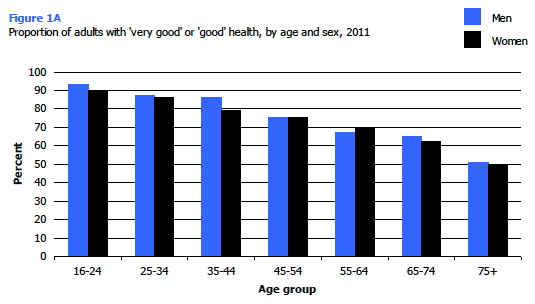
1.3 LONG-TERM CONDITIONS
1.3.1 Introduction
All participants were asked if they had any long-term physical or mental conditions or disabilities that had affected - or were likely to affect - them for at least twelve months. Those who reported having such a condition were asked to say whether it limited their daily activities in any way. This enabled conditions to be further classified as either 'limiting' or 'non-limiting'. As the question did not specify that conditions had to be doctor-diagnosed, responses were subject to some distortion due to variation in individuals' perceptions.
1.3.2 Trends in prevalence of long-term conditions since 2008, by age and sex
In 2011, 44% of adults reported a long-standing physical or mental condition or disability. This is a significant increase on the proportions reporting such a condition in 2008 (41%) and 2009 (40%).
Women were more likely than men to report having a limiting long-term condition (30% and 26% respectively).
The prevalence of long-term conditions increased sharply with age, but the gradient was much steeper for limiting conditions than non-limiting ones. For example, 11% of both men and women aged 16-24 reported a limiting long-term condition, compared with 55% of men and 60% of women aged 75 and over. The equivalent figures for non-limiting conditions ranged between 12% and 22% for men, and 10% and 21% for women, and while prevalence was lower among the younger age groups, the pattern was not wholly linear. Table 1.2
1.3.3 Long-term conditions (age-standardised) by Scottish Index of Multiple Deprivation (SIMD)
Two measures of SIMD are being used throughout this report. The first, which uses quintiles, enables comparisons to be drawn between the most and least deprived 20% of areas and the intermediate quintiles. The second contrasts the most deprived 15% of areas with the rest of Scotland (described in the tables as the '85% least deprived areas'). To ensure that the comparisons presented by SIMD are not confounded by the different age profiles of the sub-groups, the data have been age-standardised (age-standardisation is described in the Glossary). On the whole, the differences between observed and age-standardised percentages are small. Therefore, the percentages and means presented are the standardised ones only.
The proportion of adults with a long-term condition increased steadily in line with area level deprivation, from 35% of those living in the least deprived quintile to 51% in the most deprived quintile. As Figures 1B and 1C illustrate, the gradient was almost entirely accounted for by variation in the prevalence of limiting long-term conditions, rather than non-limiting ones. The association with deprivation was slightly more pronounced for women than for men. 36% of women in the least deprived quintile had a long-term condition compared with 54% of those living in the most deprived quintile. The equivalent figures from men were 33% and 49% respectively.
Those living in the 15% most deprived areas were more likely than those living in the rest of Scotland to have a long-term condition (52% and 40%, respectively). Again, the difference between the areas was particularly pronounced with limiting long-term conditions (39% of those living in the 15% most deprived areas in Scotland had a limiting condition compared with 25% of those living elsewhere). Figure 1B, Figure 1C, Table 1.3
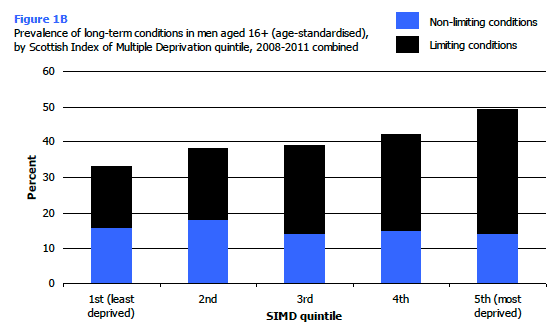
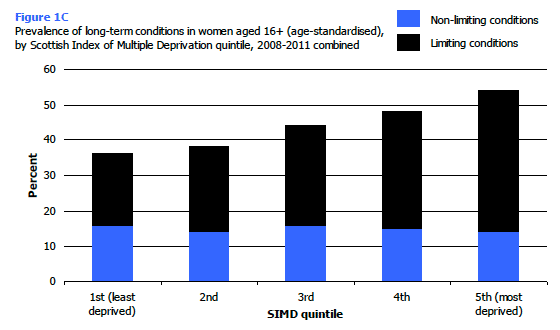
1.4 WELLBEING
1.4.1 Introduction
Wellbeing was measured using the WEMWBS questionnaire. WEMWBS is used to monitor the National Indicator "improve mental wellbeing".3 It has 14 items designed to assess: positive affect (optimism, cheerfulness, relaxation) and satisfying interpersonal relationships and positive functioning (energy, clear thinking, self-acceptance, personal development, mastery and autonomy).22 The scale uses positively worded statements with a five-item scale ranging from '1 - None of the time' to '5 - All of the time'. The lowest score possible is therefore 14 and the highest score possible is 70; the tables present mean scores.
WEMWBS is not designed to identify individuals with exceptionally high or low levels of positive mental health so cut off points have not been developed.23 The scale was designed for use in English speaking populations, however in a very small number of cases, the questions were translated to enable the participation of people who did not speak English.24
Job quality and work-life balance
In 2009 and 2011 the survey included a series of questions on working life from the adult mental health indicators set.15 As work is considered to be an important contextual factor associated with mental health, adults in paid employment or on a government training scheme were asked questions about their experience of stress at work, their work/life balance, and working conditions.25 The responses to these questions, presented by age and sex, are being published as supplementary web tables. The following analysis explores the association between mean WEMWBS scores and stress at work.
There are different theories about what determines job quality. Some researchers have emphasised the negative consequences of stress resulting from an imbalance between the efforts an employee makes and the rewards they receive in terms of recognition or payment.26 Others have focused more on the relationship between the degree of control (or autonomy) that employees feel over their work, the demands being placed on them, and the extent of any social support they receive from the organisation or fellow workers.27 Good quality work is associated with higher levels of subjective wellbeing. It should be noted that cross-sectional analysis may overstate the association between poor quality work and low levels of wellbeing because low mood might lead people to perceive their work situation more negatively. As these questions were only asked of a sub-sample of people in the study the data from 2009 and 2011 have been combined to provide a larger number of cases.
Social capital
The 2009 and 2011 surveys also included questions about other important contextual factors for mental wellbeing: social capital and people's experience of discrimination and harassment. The rationale for including such measures is set out in detail in the adult mental health indicators report.15 Social capital is a well-established concept within mental health literature and encompasses aspects of social connectedness via friend and kinship networks, trust in others, the ability to draw on support from others, as well as a sense of connectedness to places through involvement in the local community and the ability to influence local decisions.
Discrimination
Poor health and low wellbeing are among the many negative consequences for people who experience discrimination and harassment. Participants were given a list of different grounds on which people can experience discrimination and harassment (including age, gender, disability, ethnicity, religion, sexual orientation) and asked whether they had direct experience of this within the previous 12 months.28 The results are presented in full in supplementary web tables. The analysis of risk factors for low mental wellbeing presented in Section 1.5 includes the social capital, discrimination and harassment measures. As with the stress at work analysis, this analysis is based on data from the combined 2009 and 2011 surveys.
1.4.2 Trends in WEMWBS mean score since 2008, by age and sex
In 2011, the WEMWBS mean score for adults aged 16 and over was 49.9. This was not significantly different from the mean WEMWBS scores in 2008, 2009 or 2010.
Wellbeing, as assessed by WEMWBS, was higher among men (50.2) than women (49.7). This pattern is consistent with that found in previous years of the survey.
WEMWBS scores have a complex pattern of association with age. In 2011, people aged 25-34 (50.6) and 65-74 (51.0) had the highest levels of positive wellbeing and those aged 45-54 (49.0) and 75 and over (49.2) had the lowest. This pattern is broadly similar to that found in previous years of the survey and fits with the widely cited 'U-curve' in subjective wellbeing, where levels of self-reported subjective wellbeing dip during the middle years and among the oldest in society.29 Table 1.4
1.4.3 WEMWBS mean score, 2009 and 2011 combined, by job quality and work-life balance
Table 1.5 presents mean WEMWBS scores according to the responses people gave to various questions about their paid work for 2009 and 2011 combined. The items shown in the table are part of the national mental health indicator set;15 the summary rows presented are the specific indicator measures.
Job demands
Job demands (also referred to as work effort or work intensity) were captured with a question about whether employed adults felt they had 'unrealistic time pressures at work'. People who reported that this was always or often the case had a significantly lower WEMWBS mean score than those who experienced this seldom or never (48.6 compared with 51.2). This pattern was evident among both men (48.7 compared with 51.5) and women (48.4 compared with 51.0). Table 1.5
Autonomy
Autonomy, or control, in the workplace was captured with a question about how much choice employed respondents felt they had in deciding how they do their work. People in work characterised by low levels of autonomy (who reported that they seldom or never have control at work) had a significantly lower wellbeing than those who experienced this always or often (48.3 compared with 51.3). This pattern was evident among both men (48.0 compared with 51.2) and women (48.6 compared with 51.3). Figure 1D, Table 1.5
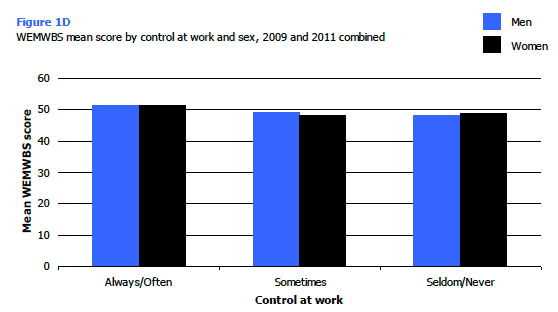
Social support in the workplace
Levels of social support in the workplace have widely been identified as a factor predicting work-related stress. Respondents were asked about social support from two sources: line managers and colleagues. People who agreed that their line manager encourages them at work had a higher WEMWBS mean score than those who disagreed (50.9 compared with 47.3). This association was particularly pronounced among men (51.0 compared with 46.8). Figure 1E, Table 1.5
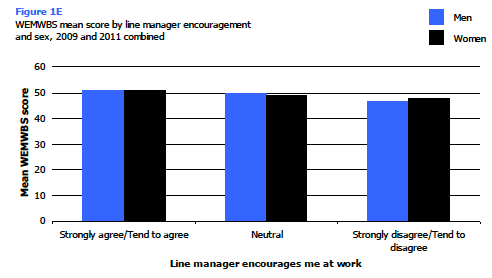
A similar pattern of association was found between perceived level of help and support from colleagues and wellbeing. The WEMWBS mean score was 50.9 among people who agreed that colleagues provided support and 45.6 among those that disagreed. It is worth noting however that very few respondents reported that colleagues did not provide support, and so while the association was significant these figures should be treated with some caution. Table 1.5
Self-perceived work-related stress
How stressful people perceived their job to be was strongly associated with their level of wellbeing. The WEMWBS mean score was 51.5 among those describing their job as not at all or mildly stressful, and 47.4 among those whose job was described as very or extremely stressful. This pattern was apparent among both men and women. A small minority of respondents found their job to be very or extremely stressful. Table 1.5
Satisfaction with work-life balance
The final measure presented in Table 1.5 is satisfaction with work-life balance. Answers were given using a scale from 0 to 10. The median score given was 7, so the data have been grouped according to whether scores were below average (0-6), average (7) or above average (8-10). Satisfaction with work-life balance was also strongly associated with wellbeing. The WEMWBS mean score was 52.4 among those who had above average satisfaction levels with their work-life balance, and 48.4 among those who had below average satisfaction. A small minority reported dissatisfaction with the balance between work and other aspects of their life. Figure 1F, Table 1.5
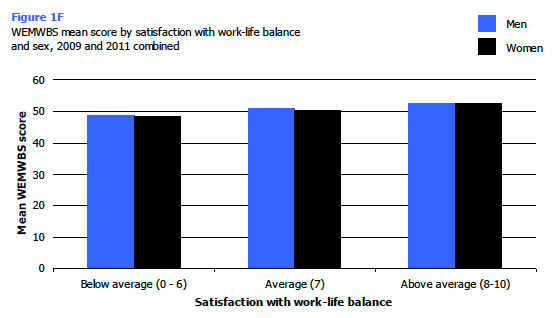
1.5 FACTORS ASSOCIATED WITH BELOW AVERAGE WELLBEING, 2009 AND 2011 COMBINED
1.5.1 Introduction
Multivariate logistic regression was used to estimate the independent effect of a range of socio-demographic and behavioural factors associated with having low wellbeing, after each factor had been adjusted for simultaneously. In these analyses low wellbeing is defined as a having a below average mean WEMWBS score. The value of multivariable analyses like these is being able to disentangle confounding factors, for example being able to test whether or not the lower levels of wellbeing observed among people who are not married or cohabiting is due to the age profile of this group.
A large number of socio-demographic and behavioural factors were tested for significance. These were:
- socio-demographic characteristics (age group, equivalised household income, household NS-SEC, highest educational qualification, economic activity and marital/partnership status);
- health status (self-reported general health and limiting longstanding illness);
- health behaviours (smoking, alcohol consumption, fruit and vegetable consumption and physical activity level);
- discrimination (discrimination and harassment);
- social capital and support (trust in people generally, trust in people in the neighbourhood, involvement in local community, influence over local decisions, how often contact people and how many friends can contact in a crisis); and
- neighbourhood deprivation (SIMD quintile).
Regression models were run on combined 2009 and 2011 data for all adults (data not shown) and then run separately for men and women. The odds ratios of having below average wellbeing are presented in Table 1.6. In these analyses, the odds of a reference group (shown in the table with a value of 1) are compared with that of the other categories for each of the individual factors. In this example, an odds ratio of greater than one indicate that the group in question had higher odds of low wellbeing and an odds ratio of less than one mean they had lower odds of having low wellbeing compared to the reference group. Odds ratios whose confidence intervals contain the value 1 are not significantly different to the reference category. By simultaneously controlling for a number of factors, the independent effect each factor has on the variable of interest can be established. For more information about logistic regression models and how to interpret their results see the glossary at the end of this volume.
1.5.2 Results
Socio-demographic factors
Overall, sex was a significant predictor of wellbeing; women had higher odds than men of having a below average WEMWBS score (odds ratio of 1.30, data not shown). The following results are based on separate models for men and women.
Age group and marital status were associated with wellbeing for both men and women. People aged 16-44 had double the odds of having low wellbeing than those aged 65 and over (odds ratios for men and women aged 65 and over were 0.53 and 0.48 respectively). With regards marital status, single women had significantly higher odds of having a below average WEMWBS score than women who were married or in a civil partnership (odds ratio of 1.62). While the overall association between marital status and low wellbeing was significant for men, the nature of the relationship was not clear.
Education level was a significant predictor of wellbeing among women, but not men. Women with no qualifications had twice the odds of low wellbeing compared with women with a degree (odds ratio of 2.00). While education level was not significant for men overall, men educated to standard grade (or equivalent qualification) level did have significantly higher odds of low wellbeing compared with men with a degree or higher qualification (odds ratio of 1.82).
Once other factors were controlled for neither household income or socio-economic classification (NS-SEC) were significantly associated with low wellbeing.
Health status
Men who assessed their general health as bad or very bad had odds six times greater than men who assessed their health as good or very good (odds ratio of 6.03). The comparable odds for women were five (odds ratio of 5.18). For both men and women, those who defined their longstanding condition as limiting had higher odds of low wellbeing than people with a non-limiting illness (odds ratio of 0.34 for men and 0.49 for women).
Health behaviours
Physical activity level was the only health behaviour found to significantly predict below average wellbeing after other factors were controlled for. Among men, the odds of those with low physical activity levels were 1.61 times higher than those meeting the physical activity recommendations. For women, there was no independent significant association between physical activity levels and below average wellbeing for women.
Discrimination and harassment
While both experience of discrimination or unfair treatment and of harassment were significant univariate predictors of wellbeing, harassment was no longer significant once discrimination and other factors were controlled for. This suggests that the fact that discrimination is perceived to be motivated by personal characteristics may be more detrimental to wellbeing than the act of the harassment itself. Men who reported experiencing discrimination in the previous year had increased odds of low wellbeing (2.02) compared with men who did not report experiencing discrimination. Experience of discrimination was also significantly associated with low wellbeing for women (odds ratio of 1.68).
Social capital and support
The two aspects of social capital that significantly predicted wellbeing were the number of people that participants said they could turn to in a crisis, and the extent to which they said they felt involved in their local community. The odds of having below average wellbeing were highest among men and women reporting that they had three or fewer people that they could turn to in a crisis.
Similarly, those who said that they were 'not at all' involved in the local community had the highest odds of having a below average wellbeing score (odds ratios of 2.08 among men and 1.86 among women). Table 1.6
1.6 DEPRESSION AND ANXIETY
1.6.1 Introduction
Details of anxiety and depression symptoms are collected in the nurse interview via a standardised instrument, the Revised Clinical Interview Schedule (CIS-R). The CIS-R is a well-established tool for measuring the prevalence of mental disorders.30 The CIS-R comprises 14 sections, each covering a type of neurotic symptom and asks about presence of symptoms in the week preceding the interview. Prevalence of two of these neurotic symptoms - depression and anxiety - were introduced to the survey in 2008. Questions about suicide attempts and self-harm were also asked, and are reported below. Given the potentially sensitive nature of these topics, these questions were included in the nurse interview part of the survey.31 Because only a sub-sample of adults was invited to participate in the nurse interview the results that follow are based on combined data from 2008 and 2009, and from 2010 and 2011. This allows for greater accuracy when figures are presented for different age or socio-demographic groups.
The following two mental health indicators are based on the data reported here:13
Percentage of adults who have a symptom score of 2 or more on the depression section of the CIS-R.
Percentage of adults who have a symptom score of 2 or more on the anxiety section of the CIS-R.
1.6.2 Symptoms of depression
The proportion of people with two or more symptoms (indicating depression of moderate to high severity) in 2010/2011 (7%) was broadly similar to levels in 2008/2009 (8%). There has, however, been an increase in the proportion with one symptom, from 5% in 2008/2009 to 12% in 2010/2011. This pattern was evident for both men and women (between the two periods, the proportion with one symptom increased from 4% to 11% in men, and from 6% to 13% in women.
For every age group (except 16-24 year olds) there was a small decline in the proportion with two or more symptoms of depression between 2008/2009 and 2010/2011. The overall increase in the proportion with one symptom of depression was true of all age groups.
Looking at the age patterns separately for men and women shows a slightly different picture. The increase in depression symptoms was particularly evident in men aged 16-34 and 45-54, and women aged 35-44 and 65-74, though the relatively small sample sizes for these sub-groups mean that strong inferences cannot be drawn from these patterns. However, it is plausible that the overall increase in the prevalence of depressive symptoms in this period could be attributed to the worsening economic conditions in 2010/2011 compared with 2008/2009.
Focusing on the 2010/2011 figures, depressive symptoms were more common in women (13% had one symptom, 8% had two or more) than men (11% and 5%, respectively). The presence of depressive symptoms was not associated with age. Table 1.7
1.6.3 Symptoms of anxiety
There was no significant change in the prevalence of anxiety symptoms between 2008/2009 and 2010/2011. The proportion of people with two or more symptoms (indicating anxiety of moderate to high severity) remained at 9% in 2010/2011. The proportion with just one symptom was also very similar (9% in 2008/2009 and 7% in 2010/2011).
As Figure 1G illustrates, anxiety was associated with gender, with women more likely than men to have symptoms (in 2010/2011, 9% of women and 5% of men had one symptom, and 10% and 8% had two or more, respectively).
There was a significant association between anxiety and age. For men aged 16-54, prevalence of two or more symptoms ranged from 8-9%, it was 7% for those aged 55-74 and just 1% at age 75 and over. Women aged 25-54 were twice as likely as women of other ages to have two or more symptoms of anxiety (14%-15% compared with 5%-7%). The presence of any symptoms of anxiety (i.e. one or more symptoms) was lowest among men aged 65 and over and highest among women aged 25-54 (with a particular peak in the 25-34 age group) (data not shown). Figure 1G, Table 1.7
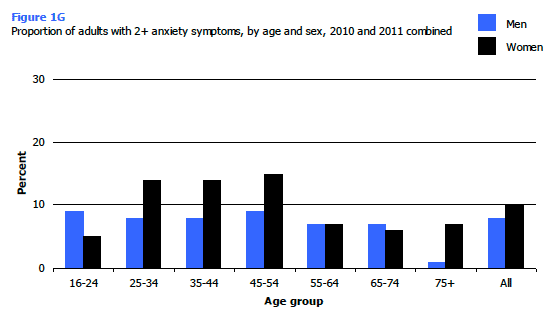
1.7 SUICIDE ATTEMPTS AND DELIBERATE SELF-HARM
1.7.1 Introduction
In addition to being asked about symptoms of depression and anxiety, those who took part in the nurse visit were also asked whether they had ever attempted to take their own life. The question was worded as follows:
Have you ever made an attempt to take your own life, by taking an overdose of tablets or in some other way?
Those who said yes were asked if this was in the last week, in the last year or at some other time. Note that this question is likely to underestimate the prevalence of very recent attempts, as people might be less likely to agree to take part in a survey immediately after a traumatic life event such as this and due to underreporting in response to a question administered face to face. Furthermore, suicide attempts will only be captured in a survey among people who have not succeeded.
Participants in the nurse visit were also asked whether they had ever deliberately harmed themselves but not with the intention of killing themselves.
1.7.2 Suicide attempts
The NHS Scotland HEAT target is to reduce the suicide rate between 2002 and 2013 by 20 percent.32 In 2011, 639 males and 250 females died from suicide and the age standardised suicide rate for 2009-11 was 14.5 deaths per 100,000 population.33 Between 2000-02 and 2009-11, there was an overall downward trend of 17% in suicide rates.
In SHeS 2010/2011, 5% of adults reported having attempted suicide at some point in their life. This was very similar to the 2008/2009 figure of 4%. While death records indicate that men are markedly more likely than women to complete a suicide,34 survey data indicate that women are more likely to report having made an attempt. The data here confirmed this pattern: in 2010/2011, 6% of women reported ever having made an attempt, compared with 4% of men.
Despite presenting figures based on two years of data combined, commenting on differences among age sub-groups in 2010/2011 and over time is difficult due to the small sample sizes and the greater likelihood of sample fluctuation. However, there did appear to be an association between age and reporting a suicide attempt with older people generally less likely to report an attempt than younger people, despite this variable relating to lifetime experience. This is likely to reflect several factors, such as a healthy survivor effect and issues relating to repression and diminished recall. Men aged 25-44 (5%) and women aged 35-54 (7-11%) were most likely to report a suicide attempt. However it is important to note that there were wide confidence intervals around these estimates. Table 1.7
1.7.3 Deliberate self-harm
Overall, 2% of people in 2010/2011 reported that they had ever deliberately harmed themselves without suicidal intent. 3% reported self-harm in 2008/2009. Levels of self-harm were similar for men and women. These figures are lower than that reported elsewhere, which will in part be due to the method of questioning. For example, the Adult Psychiatric Morbidity Survey conducted in England in 2007 recorded a prevalence of self-harm of 4.9% when asked in a self-completion questionnaire, and 3.4% when asked in a face to face interview.35 The 2008-2011 SHeS self-harm questions (along with the suicide, depression and anxiety questions) were asked face to face by nurses.
Self-harming was associated with age, with prevalence higher among younger age groups. It was reported by 6% of those aged 16-24 and 5% of those aged 35-44 compared with no more than 2% for all other age groups (no one aged 75 and over reported ever having self-harmed). The lower reporting among older age groups may be subject to similar factors as discussed above in relation to suicide attempts. Table 1.7
Contact
Email: Julie Ramsay
There is a problem
Thanks for your feedback